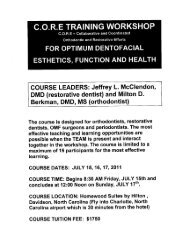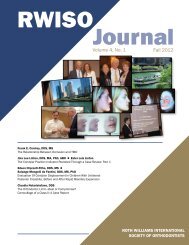2010 RWISO Journal - Roth Williams International Society of ...
2010 RWISO Journal - Roth Williams International Society of ...
2010 RWISO Journal - Roth Williams International Society of ...
You also want an ePaper? Increase the reach of your titles
YUMPU automatically turns print PDFs into web optimized ePapers that Google loves.
Figure 4-c The extracellular activity <strong>of</strong> MMPs is controlled by the<br />
presence <strong>of</strong> inhibitory proteins called tissue inhibitors <strong>of</strong><br />
metalloproteinases, or TIMPs. TIMPs bind directly to the<br />
MMPs, causing conformational changes that prevent the<br />
destruction <strong>of</strong> matrix proteins.<br />
MMPs and Arthritis<br />
The hallmark sign <strong>of</strong> arthritis is articular bone loss. In the<br />
past, clinicians have differentiated between inflammatory arthritis<br />
and osteoarthritis (OA). Recently, however, the cellular<br />
processes that result in bone and cartilage loss in both forms<br />
<strong>of</strong> arthritis have been shown to be quite similar. 11 While inflammatory<br />
arthritis is promoted by a systemic problem, the<br />
result is an inflammatory cytokine cascade, which ultimately<br />
results in osteoclastic activity and bone loss at the articular<br />
surface. OA is not a systemic problem but a local one, secondary<br />
to oxidation reactions, free radical production, or sheer<br />
stress—all three <strong>of</strong> which result from overuse. 12, 13 Despite<br />
the localized nature <strong>of</strong> OA, the cascade <strong>of</strong> cellular events that<br />
cause articular surface loss is the same as the systemically induced<br />
cascade. An increase in TNF-α and IL-1β increases the<br />
number <strong>of</strong> osteoclasts and their activity. TNF-α, IL-1β, IL-<br />
6, and RANKL all cause increased expression <strong>of</strong> the MMP<br />
genes. The end result is destruction <strong>of</strong> cartilage, bone, and<br />
connective tissue in both arthritis models. 14-18<br />
MMPs also respond to systemic hormones such as estrogen,<br />
vitamin D, and parathyroid hormones. We found an association<br />
between low estrogen levels and low vitamin D levels<br />
in patients with severe condylar resorption. 3 All <strong>of</strong> these<br />
hormones and cytokines are intimately involved in osteoclast<br />
differentiation and activation. This makes sense: MMPs are<br />
osteoclast produced and are responsible for bone and cartilage<br />
destruction.<br />
MMPs and the TMJ<br />
There is substantial evidence indicating that MMPs play an<br />
important role in bone and cartilage degradation associated<br />
with degenerative temporomandibular joint (TMJ) arthriti-<br />
des. This evidence supports the presence <strong>of</strong> 6 <strong>of</strong> the known<br />
28 matrix metalloproteinases (MMP-1, MMP-2, MMP-3,<br />
MMP-8, MMP-9, and MMP-13) in fluid or tissue samples<br />
obtained from diseased human TMJs. 13, 16, 17, 19-34 Some cases<br />
<strong>of</strong> degenerative joint disease also result from an imbalance<br />
between the activities <strong>of</strong> MMPs and TIMPs, favoring unreg-<br />
35, 36<br />
ulated degradation <strong>of</strong> tissue by MMPs.<br />
Tetracyclines<br />
Because MMPs are found to be elevated in patients with<br />
TMJ arthritis and are so destructive to articular tissues, finding<br />
a way to reduce their activity or their production would<br />
be helpful in treating patients with arthritis and condylar<br />
resorption.<br />
From 1972-1982, at the School <strong>of</strong> Dental Medicine in<br />
Stony Brook New York, Ramurmathy and Golub discovered<br />
that tetracyclines have anti-collagenolytic properties.<br />
In 1998, Golub and colleagues showed that tetracyclines<br />
inhibit bone resorption in two ways—by controlling the expression<br />
and activity <strong>of</strong> MMPs and by regulating osteoclasts<br />
and their activity. 37<br />
Controlling MMPs With Tetracyclines<br />
Tetracyclines inhibit MMPs by chelating zinc and by regulating<br />
MMP gene expression. As noted above, MMPs need<br />
zinc to actively cleave collagen proteins. Tetracyclines bind<br />
divalent ions, such as zinc. By reducing the amount <strong>of</strong> free<br />
zinc in tissues, tetracyclines reduce the number <strong>of</strong> MMPs<br />
available. 38 In addition, tetracyclines bind to the MMP itself,<br />
which causes a conformational change in the enzyme, inactivating<br />
it (Figure 5). 39 Tetracyclines have also been shown to<br />
decrease the transcription <strong>of</strong> MMPs by blocking both pro-<br />
40, 41<br />
tein kinase C and calmodulin pathways.<br />
Figure 5 Tetracycline binds directly to the zinc <strong>of</strong> the MMP.<br />
This deactivates the enzyme and protects the matrix<br />
from degradation. Tetracycline also controls osteoclastic<br />
activity and MMP transcription.<br />
<strong>RWISO</strong> <strong>Journal</strong> | September <strong>2010</strong><br />
39








